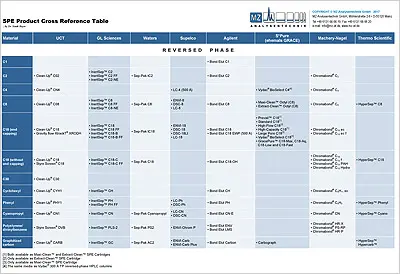- 3% Discount on online orders
- Fast Delivery Times
- DIN ISO 9001:2015 Certified
- Manufacturer Expertise
- Contact Us
Checkout using your account
Checkout as a new customer
Creating an account has many benefits:
- See order and shipping status
- Track order history
- Check out faster
SPE Cartridges
Solid Phase Extraction (SPE)
SPE cartridges are an essential tool in solid phase extraction (SPE), which are used for the enrichment of analytes and the removal of interfering matrix components and accompanying substances . They consist of a housing filled with a sorbent to adsorb specific compounds from a sample. By using different sorbents, these cartridges can be customised to extract a variety of analytes from different matrices, making them a versatile tool in laboratories, especially in environmental analysis, bioanalysis and food control.
Our MZ-AT range includes many SPE cartridges from well-known manufacturers such as GL Sciences, United Chemical Technologies, S'Pure, Waters and Welch. We would be happy to provide you with customised offers of selected SPE cartridges suitable for your analysis. Simply contact us using the contact button!
Products
Technical Data
How does solid phase extraction work?
The sample solution is passed through a solid carrier material (sorbent) under positive or negative pressure, to which the analytes are reversibly adsorbed through specific interactions. Ideally, solvents, sample matrix and other accompanying substances are not retained and can be removed by washing. The analytes are then desorbed from the solid carrier using a suitable solvent. This process is called elution. Another possibility of solid phase extraction is that the analytes are not retained by the sorbent as in the above case, but rather the matrix components and accompanying substances. Ideally, the analyte molecules do not interact with the solid carrier material and can simply be washed from the sorbent. In this case, the solid phase therefore only serves as a kind of filter.
What are the differences between the various SPE materials?
The same stationary phases are used for solid phase extraction as in chromatography columns. They are based on silica gel, aluminium oxide, magnesium silicate, graphitised carbon or polymeric phases, such as styrene-divinylbenzene copolymer. The "standard" phases, based on silica gel or polystyrene-divinylbenzene, are available in a variety of modifications or as mixed-mode phases. The pore widths used range from approx. 60 Å to 500 Å, so that a suitable material is available for a wide range of molecule sizes. The particle sizes used range from approx. 13 to 500 µm, with the 40 to 100 µm range being the most commonly used.
The right column for you - we will be happy to support you individually
Competent consultants are always at your side. Write a message to our consultants, we will get back to you and give you individual support.

